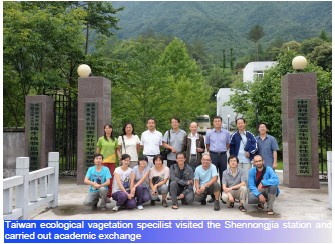National Field Station for Forest Ecosystem in Shennongjia (NFSFES) (also known as Shennongjia Biodiversity Research Station of CAS.) locates in the Qinling-Daba Mountains, which is one of the key regions for national and international biodiversity conservation. NFSFES aims to carry out long-term investigation and study on the structure/function/dynamics of northern sub-tropical forest ecosystem, and illuminate the underlying mechanism sustaining its stability. NFSFES is a member of National Field Research Station Network and China Ecosystem Research Network. Currently, NFSFES can support 30 scientists' academic activities, owns 29 series of standardized instruments and facilities, and has permanent field plots with a total area of up to 13 hm2. NFSFES now hold 8 research fellows, 2 technicians and 15 postgraduate students. In 2011, NFSFES successfully applied 6 projects from National Natural Science Foundation of China etc., published 16academic papers (includes 11 SCI papers).
The karst area in southwestern China is unique when compared to other karst areas at similar latitudes, because of its abundant precipitation, with rainfall concentrated in the growing season. In theory, resistance to water stress-induced cavitation via air seeding should be accompanied by decreased pore hydraulic conductivity and stem hydraulic conductivity. However, evidence for such trade-offs across species is ambiguous. We measured hydraulic structure and foliar stable carbon isotope ratios of 31 karst woody plants at three locations in Guizhou Province, China, to evaluate the functional coordination between resistance to cavitation and specific conductivity. We also applied phylogenetically independent contrasts (PICs) analysis in situations where the inter-species correlations of functional traits may be biased on the potential similarity of closely related species. The average xylem tension measurement, at which 50% of hydraulic conductivity of the plants was lost (Ψ50), was only 1.26MPa. StemΨ50 was positively associated with specific conductance (Ks) (P<0.05) and leaf specific conductance (Kl) (P<0.05). However, the PIC correlation for both relationships was not statistically significant. δ13C was positively related to Kl in both the traditional cross-species correlation analysis and the corresponding PIC correlations (P<0.05). The Huber value (sapwood area : leaf area ratio) was negatively correlated with Ks in both the traditional cross-species correlation and the corresponding PIC correlations (P<0.01). The characteristics of hydraulic architecture measured in this study showed that karst plants in China are not highly cavitation-resistant species. This study also supports the idea that there may not be an evolutionary trade-off between resistance to cavitation and specific conductivity in woody plants. Whole-plant hydraulic adjustment may de-couple the trade-off relationship between safety and efficiency at the branch level.

